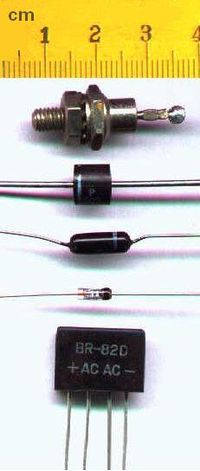This is an old revision of this page, as edited by 114.30.122.2 (talk) at 08:30, 9 August 2012. The present address (URL) is a permanent link to this revision, which may differ significantly from the current revision.
Revision as of 08:30, 9 August 2012 by 114.30.122.2 (talk)(diff) ← Previous revision | Latest revision (diff) | Newer revision → (diff)


In electronics, a diode is a two-terminal electronic component with asymmetric transfer characteristic, with low (ideally zero) resistance to current flow in one direction, and high (ideally infinite) resistance in the other. A semiconductor diode, the most common type today, is a crystalline piece of semiconductor material with a p-n junction connected to two electrical terminals. A vacuum tube diode, now rarely used except in some high-power technologies and by enthusiasts, is a vacuum tube with two electrodes, a plate (anode) and cathode.
The most common function of a diode is to allow an electric current to pass in one direction (called the diode's forward direction), while blocking current in the opposite direction (the reverse direction). Thus, the diode can be viewed as an electronic version of a check valve. This unidirectional behavior is called rectification, and is used to convert alternating current to direct current, including extraction of modulation from radio signals in radio receivers—these diodes are forms of rectifiers.
However, diodes can have more complicated behavior than this simple on–off action. Semiconductor diodes do not begin conducting electricity until a certain threshold voltage or cut-In voltage is present in the forward direction (a state in which the diode is said to be forward-biased). The voltage drop across a forward-biased diode varies only a little with the current, and is a function of temperature; this effect can be used as a temperature sensor or voltage reference.
Semiconductor diodes' nonlinear current–voltage characteristic can be tailored by varying the semiconductor materials and introducing impurities into (doping) the materials. These are exploited in special-purpose diodes that perform many different functions. For example, diodes are used to regulate voltage (Zener diodes), to protect circuits from high voltage surges (avalanche diodes), to electronically tune radio and TV receivers (varactor diodes), to generate radio frequency oscillations (tunnel diodes, Gunn diodes, IMPATT diodes), and to produce light (light emitting diodes). Tunnel diodes exhibit negative resistance, which makes them useful in some types of circuits.
Diodes were the first semiconductor electronic devices. The discovery of crystals' rectifying abilities was made by German physicist Ferdinand Braun in 1874. The first semiconductor diodes, called cat's whisker diodes, developed around 1906, were made of mineral crystals such as galena. Today most diodes are made of silicon, but other semiconductors such as germanium are sometimes used.
History
Although the crystal semiconductor diode was popular before the thermionic diode, thermionic (vacuum tube) diodes and [[solid state (electronics)|solid shis modified light bulb effectively replaced the resistor in a DC
- "Physical Explanation – General Semiconductors". 2010-05-25. Retrieved 2010-08-06.
- "The Constituents of Semiconductor Components". 2010-05-25. Retrieved 2010-08-06.